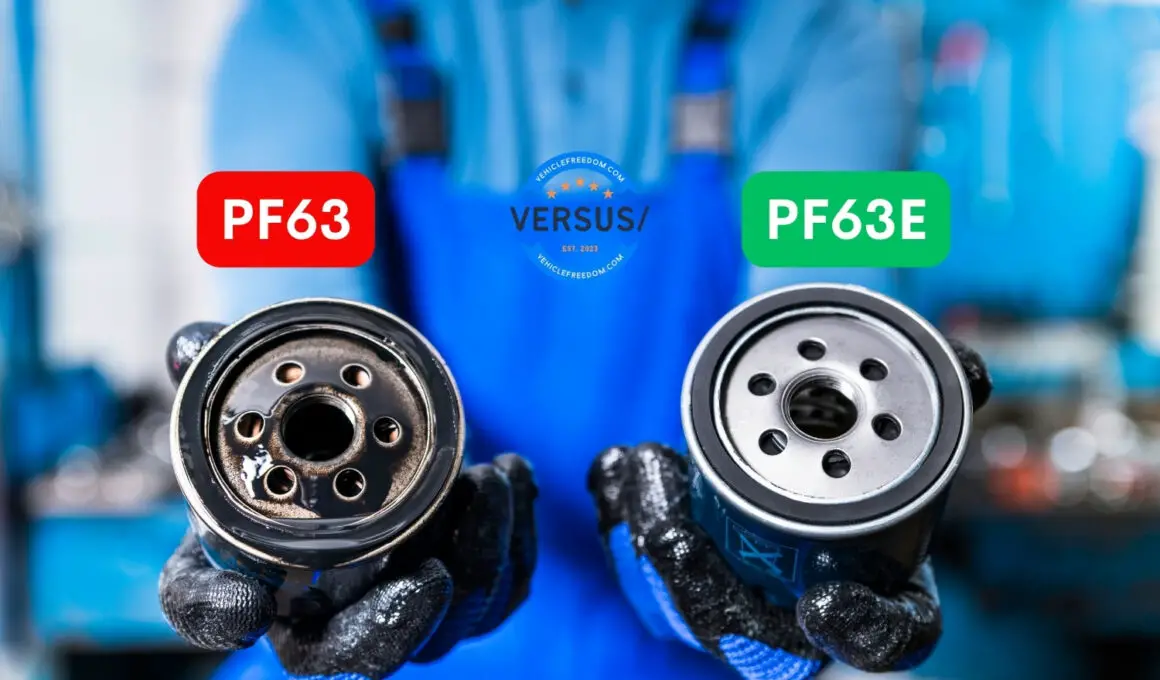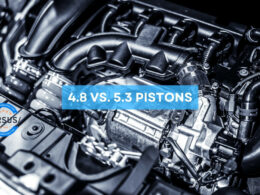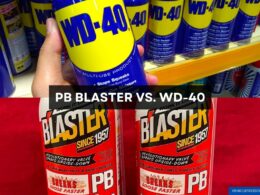In This Article Show
With over 13 years under my belt as a mechanic, I’ve witnessed firsthand the evolution of various vehicle components. One such component that often goes overlooked but plays a vital role in keeping our vehicles running smoothly is the not very often-discussed oil filter.
Now, I might spend my days getting greasy hands and troubleshooting car problems, but I’ve also taken to the world of blogging to share my expertise. Today, we’re delving deep into the distinctions between two popular oil filter models: the PF63 and the PF63E.
You might think: “It’s just an oil filter, how complex can it be?” While the basics remain unchanged, the specifics can make all the difference. When I first started in the field 13 years ago, I quickly realized that the tiniest details could affect a vehicle’s performance. Let’s get into it.
The Basics of Oil Filters
Before we dive into the specifics of the PF63 and PF63E, let’s get everyone on the same page about what oil filters do and why they’re so crucial.
Imagine the blood in our bodies. It circulates, delivers essential nutrients and oxygen, and picks up waste in the process. Now, think of your car’s engine oil as its “blood”. As it circulates through the engine, it lubricates vital parts, reduces friction, and carries away contaminants and minute metal particles. These impurities, if left unchecked, can cause significant wear and tear on the engine’s components.
Enter the oil filter. Its primary job is to ensure that these contaminants don’t get a chance to cause havoc. A good oil filter captures these particles, allowing only clean oil flow. As the oil circulates through this filter, the trapped impurities build up, which is why regular changes are necessary.
If left unchanged, the filter can become clogged, leading to reduced oil flow and potentially damaging the engine.
I’ve seen engines both with and without regular filter changes. And trust me, the difference is day and night. A regularly changed oil filter ensures that your engine remains efficient, consumes less fuel, and has an extended lifespan.
When choosing an oil filter, you pick a guardian for your engine. The PF63 and PF63E are designed to be that guardian, but understanding their specific strengths and weaknesses will help you decide which stands tall for your vehicle’s needs.
PF63: An Overview
The PF63 oil filter has been a go-to choice for many vehicle owners for a good reason. Let’s start by understanding its construction and features to see why it’s earned its reputation.
Historical Context and Introduction
The PF63 was introduced as a response to the needs of modern engines. As engines became more advanced, they required more refined filtration to maintain efficiency and longevity. The PF63 was designed to cater to these evolving demands, and over time, it has become a staple for many.
Key Specifications and Features
- High-Capacity Design: The PF63 boasts a design that allows it to handle a large volume of oil without compromise, ensuring consistent oil flow and optimal filtration.
- Advanced Filtration Media: Its synthetic blend media offers 97% filtration efficiency, effectively capturing particles as small as 20-30 microns. This means even minute contaminants don’t stand a chance.
- Anti-Drain Back Valve: This feature ensures that oil remains in the filter when the engine is off, preventing dry starts and ensuring immediate lubrication upon ignition.
- Robust Construction: Made with a durable metal shell and end caps, the PF63 can withstand challenging conditions and high pressures without warping or deforming.
Commonly Used Vehicles and Applications
The PF63 is a popular choice for many mid-sized cars, SUVs, and light trucks, especially those with larger displacement engines.
Many General Motors (GM) vehicles, including Chevrolet, GMC, and Buick, have often recommended or come pre-installed with the PF63 due to its compatibility and performance.
In summary 🚙
The PF63 has established itself as a reliable and efficient oil filter, perfectly suited for vehicles that require robust filtration and a filter that can handle the demands of more powerful engines. However, as with everything in the automotive world, innovation never stops. This brings us to its evolution – the PF63E, which we’ll dive into next.
PF63E: What Sets it Apart
While the PF63 has its merits, automotive innovation never comes to a standstill. The PF63E was introduced as an evolution of its predecessor, aiming to cater to newer engine requirements and addressing any areas of potential improvement from the PF63.
Let’s dive into what makes the PF63E unique.
Introduction and Evolution from PF63
The PF63E was not merely a rebranding; it was a step forward. Understanding the ever-evolving automotive landscape, the PF63E was designed to serve modern vehicles that demanded a tad more from their oil filters due to design complexities, stricter emission norms, or other performance parameters.
Major Specifications and Differences
- Enhanced Filtration Media: The PF63E utilizes an even more refined filtration media, boasting a filtration efficiency that exceeds its predecessor. This means it can trap even finer contaminants, ensuring cleaner oil circulation.
- Improved Anti-Drain Back Valve: While the PF63 already had this feature, the PF63E’s valve boasts a better design, ensuring quicker lubrication upon engine starts, further reducing wear and tear.
- Optimized Design for Easier Installation: With the mechanics in mind, the PF63E comes with a design that simplifies the installation process, making oil filter changes quicker and hassle-free.
- Slightly Smaller Size: Though it might seem counterintuitive, the PF63E is slightly smaller than the PF63. This design choice was made to fit newer engine compartments that often prioritize space optimization without compromising on filtration capacity.
Which Vehicles Typically Use This Filter
The PF63E is ideal for several of the latest sedans, SUVs, and trucks models. Like the PF63, it’s a common choice for many GM vehicles.
However, due to its advanced features and design tweaks, it’s also becoming a favored option for several other manufacturers and models that seek refined filtration and a compact design.
In essence 📝
While the PF63 laid a solid foundation, the PF63E built upon it, considering the feedback, the shifts in the automotive industry, and the demands of newer vehicles. Both have their strengths, and their decision is specific requirements and vehicle compatibility. Next, we’ll place them head-to-head for a clearer comparison.
Head-to-Head Comparison: PF63 vs PF63E
When deciding between the PF63 and PF63E, it’s essential to weigh their features side by side. By doing a direct comparison, you can ascertain which filter is best aligned with your vehicle’s needs. Let’s get right into it.
Size and Dimension Differences
- PF63: Slightly larger in size, the PF63 was built for engines and compartments with a bit more room to spare. Its size doesn’t compromise its efficiency but may not be as suited for more modern, compact engine designs.
- PF63E: Streamlined and compact, the PF63E is a nod to the evolving design of today’s engines. This smaller size doesn’t equate to reduced capacity but rather optimization for newer vehicle models.
Material and Construction Variances
- PF63: Built with a reliable metal shell and sturdy end caps, it’s designed to endure high pressures and resist deformation.
- PF63E: While maintaining the robustness of the PF63, the PF63E incorporates slight design improvements that enhance durability and simplify the installation process.
Filtering Capabilities
- PF63: With a synthetic blend media, it offers around 97% filtration efficiency, capturing particles in the 20-30 micron range.
- PF63E: The refined filtration media of the PF63E provides superior filtration efficiency, capturing even finer contaminants and ensuring an even cleaner oil circulation.
Lifespan and Recommended Change Intervals
- PF63: Reliable and long-lasting, but, like all oil filters, it requires regular changes to maintain optimal performance. Depending on vehicle use and oil type, the change intervals might vary.
- PF63E: Given its advanced design, the PF63E might offer slightly extended intervals between changes. However, always refer to the manufacturer’s guidelines and regular oil analysis for precise intervals.
Price Comparison
- PF63: Often more affordable due to its established presence in the market.
- PF63E: Might carry a slightly higher price tag given its enhanced features. But as always, prices can vary based on retailers and promotions.
Conclusion
Both the PF63 and PF63E are top contenders in the world of oil filters. While the PF63 has reliably served many vehicles over the years, the PF63E comes with nuanced improvements catering to modern engine needs. Your choice should hinge on your vehicle’s specifications, your performance expectations, and, of course, personal preference.
Which Should You Choose?
Deciding between the PF63 and PF63E can feel a bit like being caught between two great options. After all, both filters stem from a lineage of quality and performance. However, the right choice often hinges on specific factors. Let’s delve into the considerations to keep in mind.
Vehicle Specifications
Your vehicle’s age, make, and model are critical factors. If you’re driving an older vehicle model, especially one that has consistently used the PF63, there might be no compelling reason to switch unless you’re seeking the specific advantages the PF63E offers.
Conversely, newer vehicles, particularly those with compact engine compartments or more advanced engine designs, might benefit more from the PF63E.
Performance Expectations
If you’re someone who pushes their vehicle’s limits, perhaps taking long drives or using your car in harsh conditions, you might lean towards the PF63E with its slightly superior filtration efficiency. It offers that added assurance that even the finest contaminants are being trapped.
Price Sensitivity
Budget always plays a role. If you’re looking for a reliable filter without breaking the bank, the established PF63 might be your pick. However, if you’re willing to invest a tad more for advanced features, the PF63E becomes a viable option.
Change Intervals
How often are you willing or able to change your oil filter? If you prefer slightly extended intervals (though always within the manufacturer’s recommendations), the PF63E might have the edge due to its advanced design.
Personal Experiences and Recommendations
Feedback from fellow drivers, friends, or trusted mechanics can influence a decision. If you know others who’ve had notable experiences (good or bad) with either filter, their insights can be invaluable.
Availability
While both filters are widely available, regional variations might make one more accessible than the other. It’s always practical to opt for a filter you can easily replace when needed.
Final Thoughts
Both the PF63 and PF63E are commendable choices. The decision isn’t so much about picking the superior filter but rather choosing the one that aligns best with your specific needs.
Consider the factors above, weigh the pros and cons, and make an informed choice.
Regardless of your pick, regular maintenance and timely changes are paramount. By staying diligent, you ensure that your engine remains in peak condition, whether you’re driving across town or embarking on a cross-country adventure.














